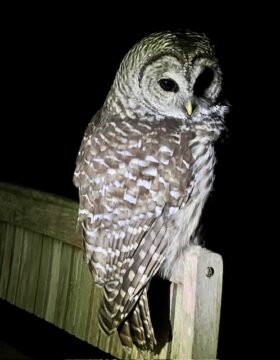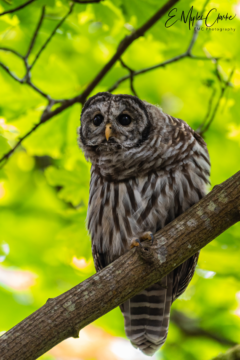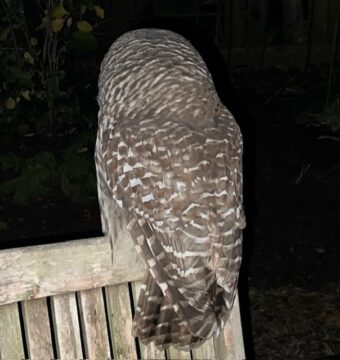by David Greer Two weeks after my wife died this past October, she briefly returned. Or so it seemed to me.
Two weeks after my wife died this past October, she briefly returned. Or so it seemed to me.
Not in the flesh, of course. Instead, I received a visit from a creature whose behavior was so unexpected, so unnerving, so uplifting, that it seemed to defy rational explanation, and I felt the presence of my wife as strongly as if she were beside me.
The visitor was a barred owl. I’m familiar with barred owls, though not with barred owls as familiars. At night, I’ve often heard from the forest the signature barred owl query, “Who cooks for you? Who cooks for you all?” Less often, I’ve been jolted awake by a bloodcurdling scream–is someone’s throat being cut?—and my heart pounds until reason clears the fog from my brain: it’s only an owl. I’ve also on occasion gone into the forest to investigate strange querulous whistles that become less strange when I spot a trio of juvenile barred owls begging a parent for food—a freshly killed fieldmouse or flycatcher—and counting on persistent whistling to do the trick.
But the owl that visited me after my wife’s death was silent. She sat outside the door, perched on the back of the garden bench on which my wife had loved to sit after walking unaided became too difficult for her. (I say ‘she’ because female barred owls are up to a third larger than males, and this was a very large owl.) There was no missing her. Barred owls are not unobtrusive. They’re smaller than a great horned owl but considerably larger than the northern spotted owl, whose habitat they have been taking over since first being observed in the Pacific Northwest in the 1970s. Their gradual spread west from their native habitat in eastern North America may have been enabled by the reforestation of parts of the prairie after the age-old indigenous practice of burning grasslands was prohibited.
Like many successful invasive species, barred owls are generalists, capable of adapting to a wide range of habitats and diets. In contrast, the spotted owl is a specialist that eats mainly pack rats and flying squirrels and can only survive in western old-growth forests that in recent decades have been in continual retreat before an unrelenting army of chainsaws. In the United States, the spotted owl obtained a reprieve from the threat of extinction most recently in December 2023, when the Biden administration announced that the logging of old-growth forests will be banned in the United States by 2025, though that decision was motivated primarily by the role of massive trees in storing carbon rather than providing spotted owl habitat.
The possibility of such a reprieve north of the border in Canada seems more problematical both because the known wild population of northern spotted owls in Canada has been reduced to one individual, since reported missing, and because the Canadian government continues to dither in response to a demand from its own environment minister that it issue an emergency order to prevent the extinction of the last (currently missing, possibly dead) wild spotted owl in Canada. Meanwhile, back in the U.S., the Fish and Wildlife Service, having concluded that barred owls pose a significant threat to spotted owl populations hard-hit by earlier timber harvesting, in November 2023 proposed a protection strategy that includes shooting over 400,000 barred owls over the next three decades. Barred owls are about to pay a high price for their adaptability.
Consider this. The spread of invasive faunal and floral species (animals and plants) accounts for a significant portion of global extinction of native species. The primary cause of the spread of invasive species is human disruption of species habitat and witting or unwitting introduction of species into alien (to them) ecosystems, the barred owl being a case in point. Ordinarily we ignore the impact of invasive species on native species until someone complains, preferably with lawyers at hand. It helps as well if the native species is cute and cuddly, especially when possessed of feathers or fur (threatened warty jumping slugs need not apply). That’s when the big guns come out. The guns employed by the U.S. Fish and Wildlife Service will no doubt be large and accurate, for the most part activated beyond the range of human hearing, and unlikely in the longer term to alter the takeover of spotted owl territory by barred owls. Invasive species are nothing if not resilient and persistent, an omnipresent symbol of survival of the fittest. It seems rather sad that we continue to throw good money after bad towards the control of invasive species while for the most part failing to address their human cause.
Does this sound like a lengthy digression from a musing on the visit of my departed wife in the form of an owl? I suppose it does, but let me explain. I’ve spent many years observing and photographing barred owls, in part because they tend to congregate outside my cabin on South Pender Island (in an open forest glade, home to a variety of songbirds and small rodents) but also I find them an endless source of fascination. Yes, they are an invasive species implicated not only in the decline of the spotted owl but also in the extirpation from these parts of western screech owls. Is that reason enough to attempt to eliminate the barred owl when for whatever reason it extends or changes its natural range? After all, the history of the planet is the history of species adapting and expanding their territory at the expense of species less able to adapt. It hardly needs to be pointed out that the most dangerous invasive species of all are the ones wearing trousers.

So I’ve always felt a special attachment to barred owls, and feeling the presence of my wife during an encounter with a barred owl was a powerful moment for me, unnerving but also uplifting in the sense that I so strongly felt her presence even though she was physically absent. I’ve always felt a keen respect for barred owls, and now that respect has been heightened further by my association of a barred owl with the memory of my wife.
Barred owls have in recent decades become common not only in old-growth forests but also in west coast cities, where their sudden silent appearance on a nearby branch can be alarming or alluring, depending on one’s outlook. I first noticed “my” owl when I closed my garage-office for the day, well into the gloaming, and headed to the house to make dinner. From her perch on the back of the bench, the owl was facing away from the house towards a stand of cedars but slowly swivelled her massive round head as I got closer, her black pupils huge in the fading light. I continued into the house, surprised that she didn’t quickly take flight when I passed close by.
After prepping dinner, I looked out the window, assuming the owl would have flown, but she hadn’t moved. I opened the door, and she turned again to gaze at me. Curious, I walked slowly towards her, and still she looked not in the least disturbed, moving her gaze from me to the forest. By the time I reached her side, so close I might have laid a hand upon her back but didn’t, she kept her face towards me, with no hint of alarm. That’s when I took the photo at the top of this article. I didn’t try to get any closer. I felt my wife’s presence so strongly that it stopped me in my tracks. My rational mind might have sought to convince me that this was all in my imagination, yet I was left feeling strangely buoyed, regardless of whether the connection was imagined or real. I understand that this experience is not uncommon among people who have lost a close and long-time partner.
What do you say to a bird that feels like the incarnation of your recently departed spouse? In my case, nothing, except to stand alongside it, willingly yielding to suspension of disbelief. I remained with the owl awhile, following her gaze into the trees, then slipped back into the house.

In the morning, the owl was gone and I was left wondering what to make of it all. In my experience, owls kept their distance, a far cry from the gray jays and chickadees which, tempted by a peanut or raisin, would without hesitation perch upon my outstretched hand. Owls are not like that. In the past I’ve been lucky if one came closer than fifty feet.
Owls have reason to keep their distance, given human unpredictability. People have a long history of fearing or revering owls, depending on their cultural tradition. One might justifiably argue that the reason owls seem so mysterious and unnerving to us is the range of their seemingly supernatural powers, which they’ve been working on since humans were hardly a gleam in the eye of one of our lemur-like ancestors.
Owls evolved around 55 or 65 million years ago after a wayward asteroid took out T-Rex and his dinosaur mates in the last mass extinction, number five. The feathered small fry that persisted through the extended planetary calamity evolved into birds. Owls took good advantage of a few million generations to evolve some impressive attributes, including the ability of some species to track and capture smaller creatures in absolute darkness, guided only by the prey’s tiniest sounds. Combine that with swift and absolutely silent flight, thanks to feather structures only recently understood, and you have an admirable killing machine. If you’re a pack rat or fieldmouse innocently going about the business of stuffing your face and you can’t see or hear or in any other way sense the lightning-rapid onset of a predator, that rather limits your options.
* * *
It’s possible that the ancient association of owls with wisdom originated in wonderment at such mysterious powers. Their ability to see and hear things hidden to humans gives owls an aura of secret knowledge and the ability to perceive truths missed by others; and, of course, there are those forward-facing eyes, so much more human than those of other birds, so intently focused and unblinking, as if seeing more than meets the eye. Small wonder that in Greek and Roman mythology the owl came to be portrayed as the constant companion of Athena, the Greek goddess of wisdom, and later of her Roman counterpart Minerva.
Hegel said, “The owl of Minerva takes its flight only when the shades of night are gathering.” By this he meant that historical events can only be truly understood when they are over and done with. In short, wisdom is achieved only in hindsight–an observation that somehow seems particularly pertinent during our own complicated times when human tribes and nations seem to blunder from one catastrophe to the next without foresight of the long-term consequences and without the insight to avoid the mistakes of the past. Perhaps if our brain hadn’t evolved so quickly compared to that of an owl, we might have evolved the ability to be wise in time to make practical use of our wisdom.
But humans have only been around a few hundred thousand years, a blink of an eye by comparison with the owl’s prolonged and steady gaze. During that time, we’ve managed to evolve opposable thumbs and a fair-sized brain. The thumbs have proved handy for making and employing tools to make life easier in our own communities as well as weapons with which to subdue folks elsewhere, also with opposable thumbs but perceived as unacceptably different in other respects.
Meanwhile, the human brain has evolved sophisticated ways to run away from immediate threats such as tigers and volcanoes but little motivation or capacity to tackle things like climate change that aren’t sufficiently scary to kill us this minute, though they might make life untenable for our grandchildren. Unfortunately, we may not have the luxury of a few more million let alon thousand years to evolve strategies to save ourselves from our worst selfish impulses. The sixth, human-caused extinction has already claimed a staggering number of species (the current rate of extinction is estimated to be between 100 and 1,000 times higher than the prehuman background rate of extinction), and it’s hard to imagine that it won’t in due course add Homo sapiens to the list.
* * *
In her 2023 book What an Owl Knows: The New Science of the World’s Most Enigmatic Birds, Jennifer Ackerman devotes a chapter to symbolic meanings of owls in cultures throughout human history. Not surprisingly, these meanings vary widely. A study of 123 ethnolinguistic groups across six continents found that, in every one of those groups, birds were seen as omens of luck or ill fortune but also as envoys, often from the world of spirits or the divine (page 239). Some cultures consider owls to be bearers of bad luck and harbingers of doom; others consider them spirit beings and gods and heralds of good fortune. Certainly the owl that visited me felt like the spirit of my wife, or at least a messenger from her world, assuring me that she was safe and whole. Not entirely rational, I know, but there it is.
In the bigger picture, entire religions are built on a foundation of fear and wonderment inspired by natural phenomena that seem inexplicable. I was raised in a religion in which one hymn included the line, “All creatures great and small / The Lord God made them all.” The simplicity and certainty of the statement seemed comforting when I was a child, and I liked the tune. When I grew a little older and encountered the theory of evolution, a different penny began to drop: was it possible that my distant forebears had invented a belief in God not only because of fear of that black hole otherwise known as death but also because no one had come up with any other explanation for the existence of such a grand variety of animals of such extraordinary beauty and possessing such complicated traits? “All creatures great and small / Natural selection made them all” didn’t have quite the same ring, but it began to make a lot more sense to me. As well, the constant bickering among religions as to which was the true faith began to seem tiresome, especially when it involved torturing those with a different point of view with such charming instruments as the Heretic’s Fork.
 Does my belief in evolution make me a diehard rationalist? I don’t think so. Not believing in a divine Creator doesn’t mean that there aren’t other forces at play outside our normal ken. Some scientists dismiss the notion of a soul because none of the four fundamental forces that scientists have observed to govern the world–gravity, the weak and strong nuclear forces, and electromagnetism–can explain the concept of a soul held inside the body. If there’s no way of measuring a soul, they say, it is simply beyond belief that such a thing exists.
Does my belief in evolution make me a diehard rationalist? I don’t think so. Not believing in a divine Creator doesn’t mean that there aren’t other forces at play outside our normal ken. Some scientists dismiss the notion of a soul because none of the four fundamental forces that scientists have observed to govern the world–gravity, the weak and strong nuclear forces, and electromagnetism–can explain the concept of a soul held inside the body. If there’s no way of measuring a soul, they say, it is simply beyond belief that such a thing exists.
The Athenian philosopher Epicurus (341-270 BC), one of the first thinkers to hypothesize that the world was composed of atoms that for the most part moved on trajectories governed by fixed physical laws, held a different view. In the case of humans, Epicurus concluded, the atoms that made up their bodies could sometimes deviate from the trajectories determined by the laws of physics, and the reason for those deviations was the existence of a human soul, though Epicurus did not believe in an afterlife for the soul.
A modern scientist might raise a quizzical eyebrow at Epicurus’s belief in the soul and, quite reasonably, ask to be shown the proof. But what if there are forces that exist on a plane as yet unknowable to humans? After all, modern science is constantly shattering conceptions that previous generations of scientists held to be incontrovertible, as science patiently plods across new frontiers of knowledge.
I’ll leave the last word to Hamlet, musing on the battlements of Elsinore, “There are more things in heaven and earth, Horatio, / Than are dreamt of in your philosophy” (Act I, Scene v). Amen to that.
As for me, I’m disinclined to weigh in on the existence of a soul, and I’m equally agnostic about the afterlife, but I aim to keep an open mind and to pay attention when an owl calls my name.
